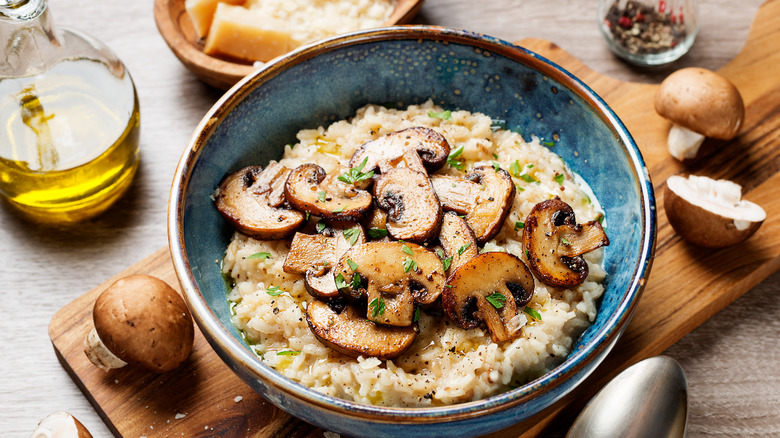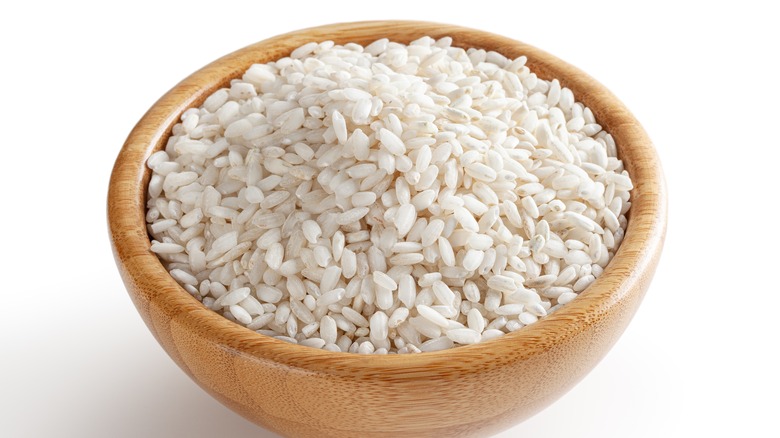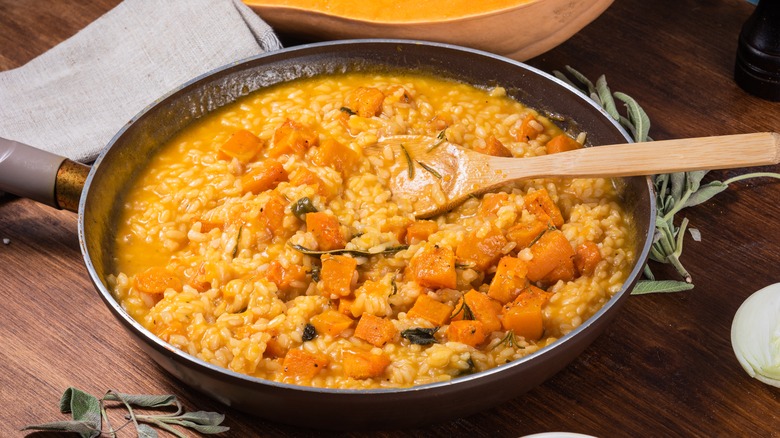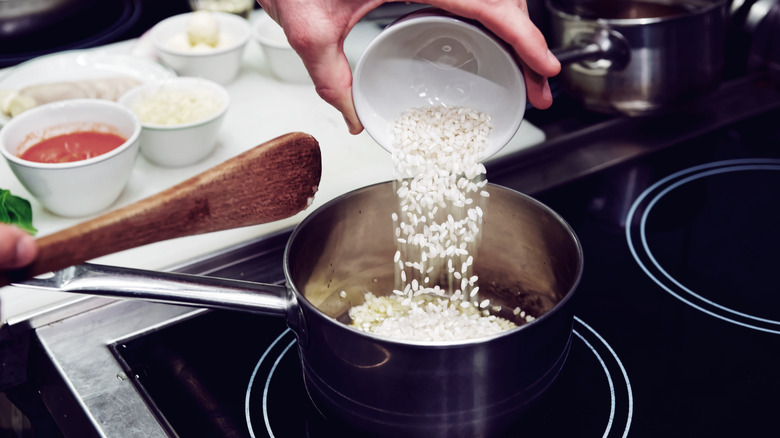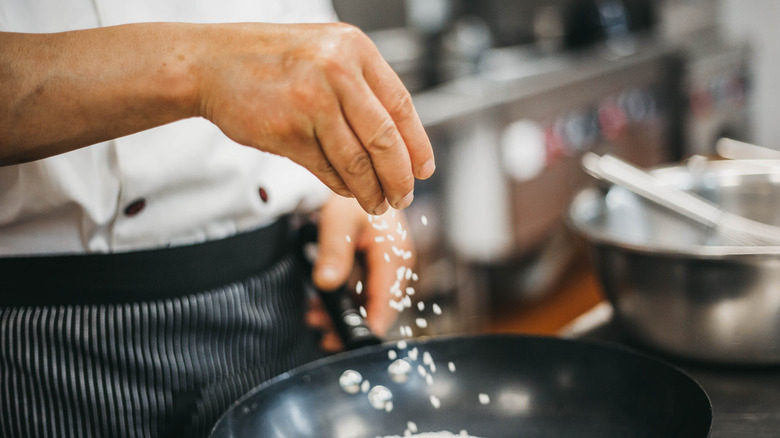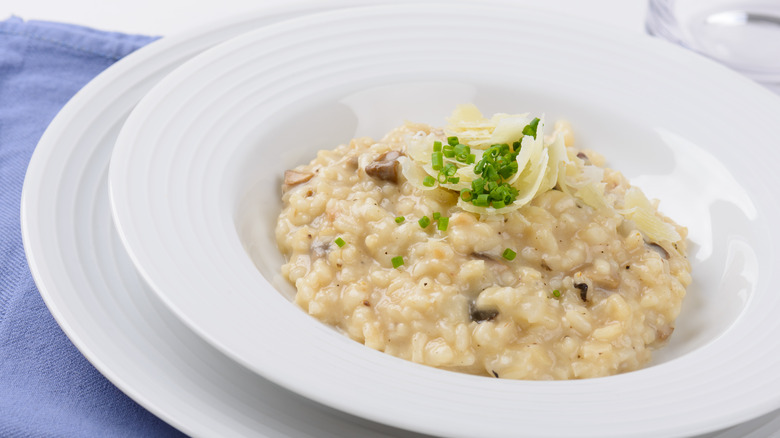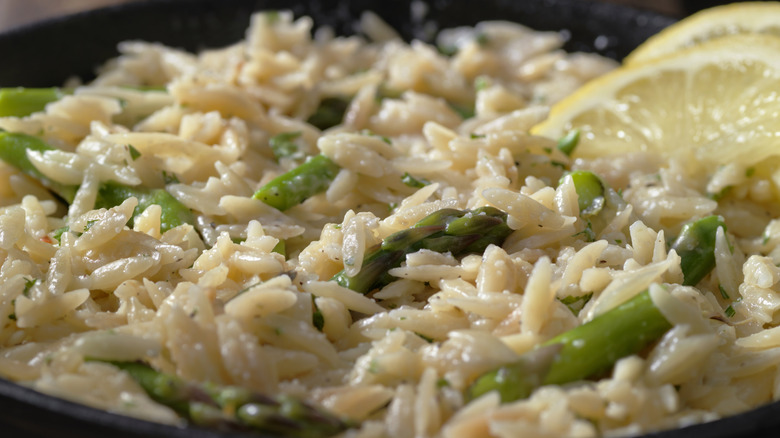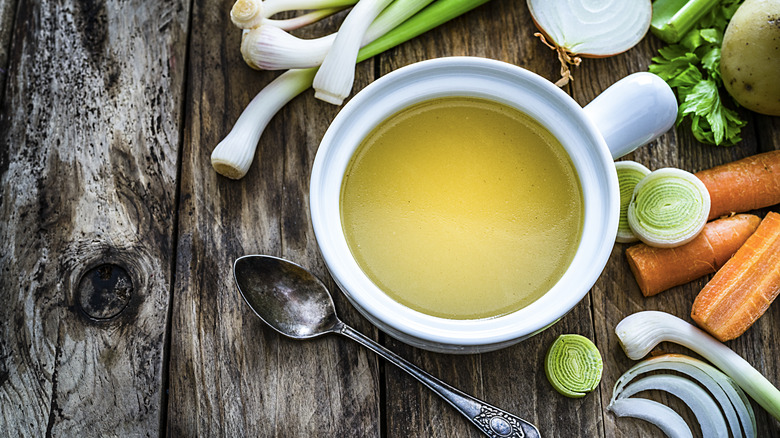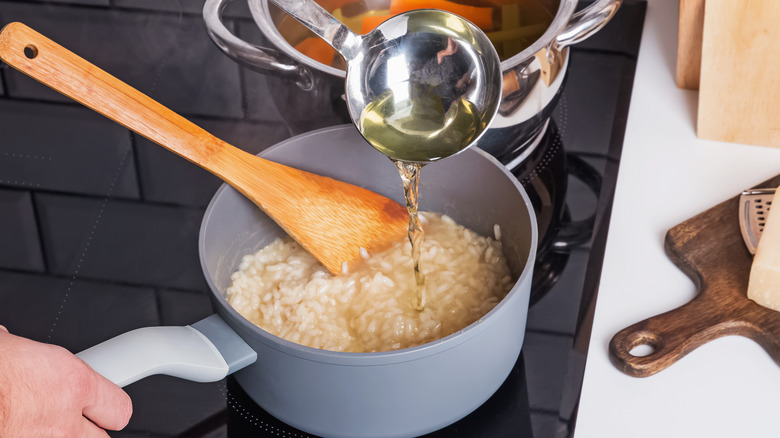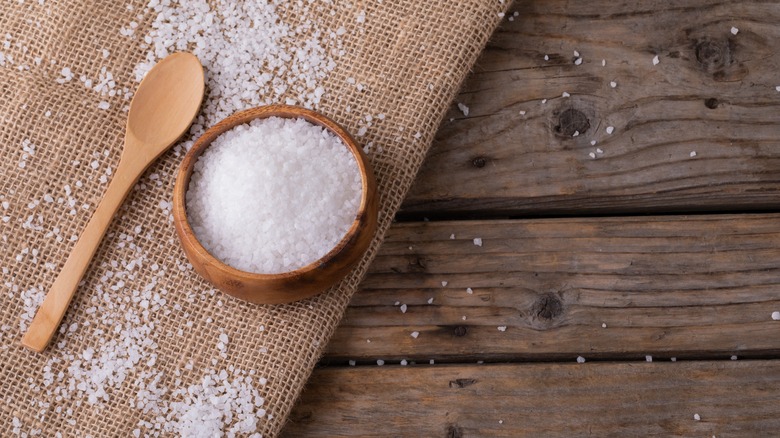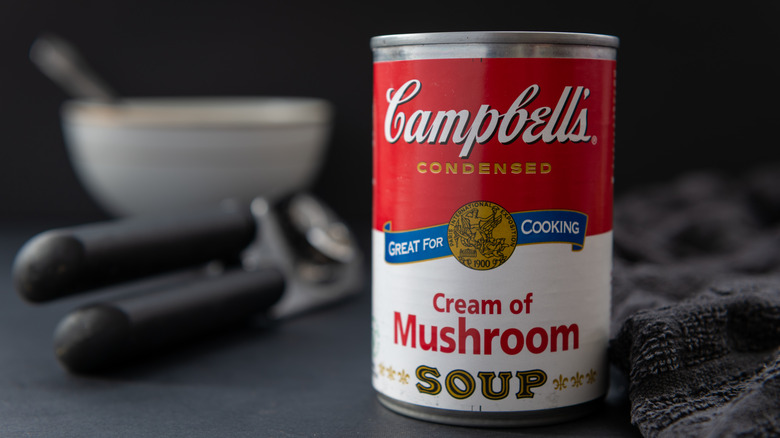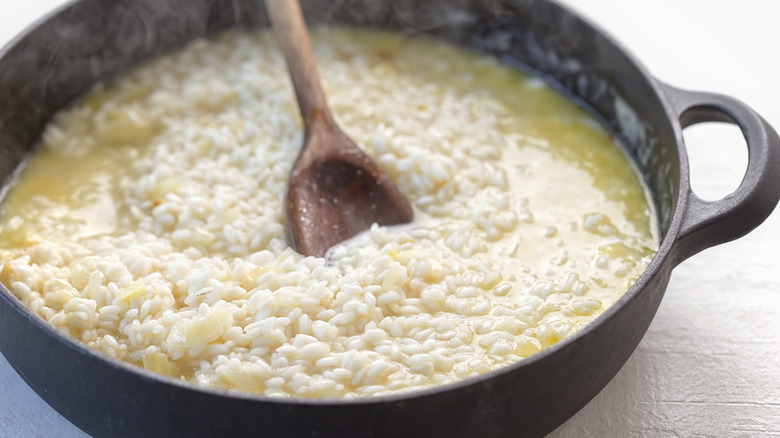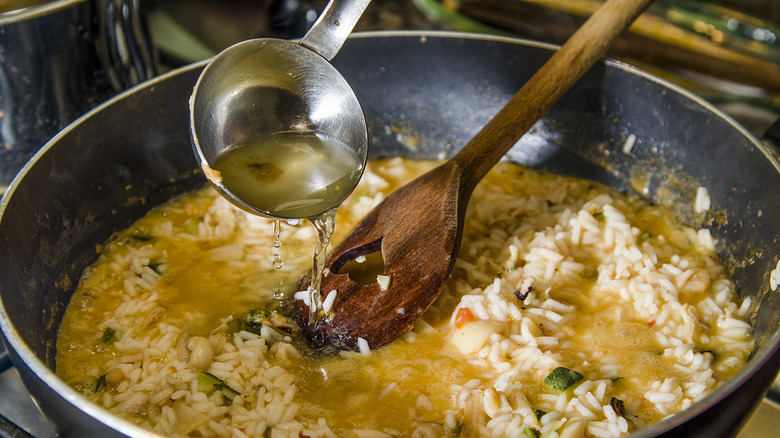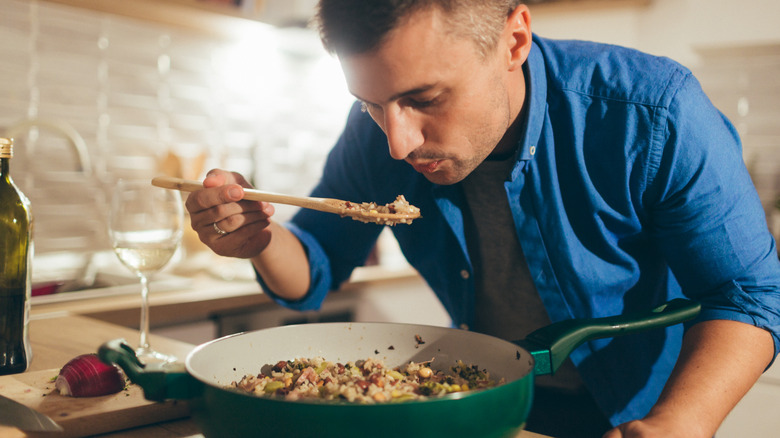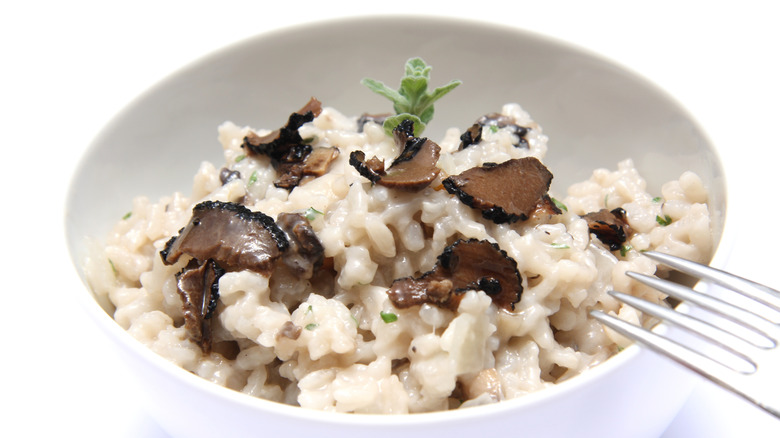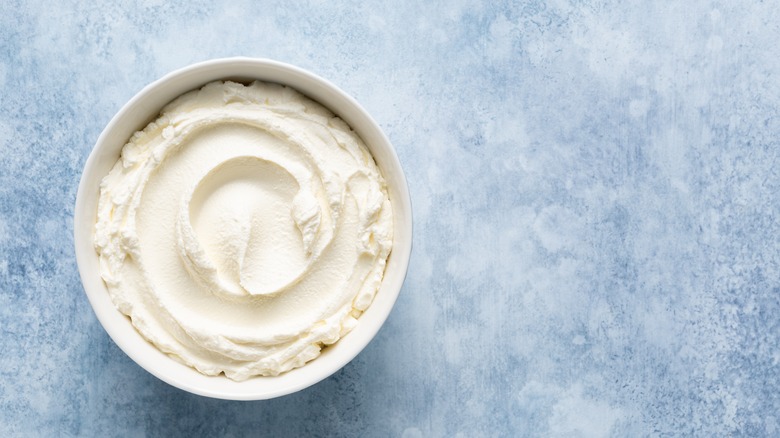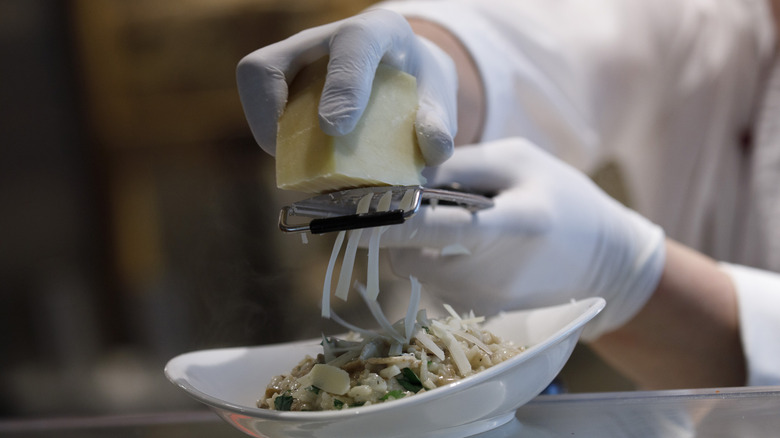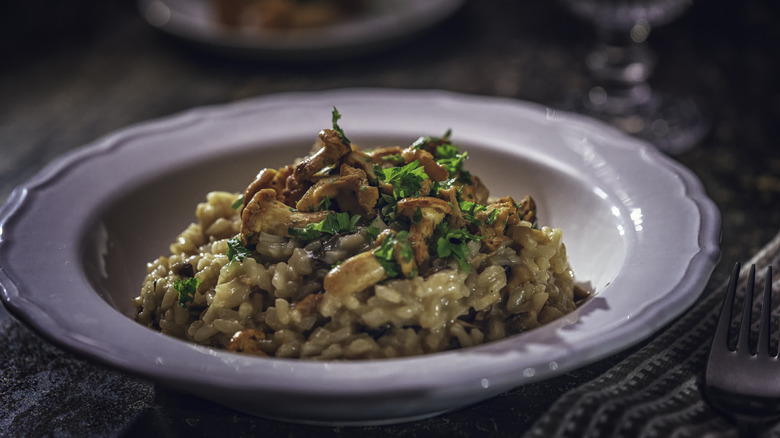18 Mistakes You're Making With Risotto
It's soft, it's savory, and it's decadently creamy — it's risotto! This Italian classic is one of the most filling foods you can make on a relatively small budget any time of year. One of the best parts about the dish is that you can infuse it with whatever ingredients you have in your kitchen, like mushrooms, shallots, garlic, seafood, and meat. You can also modify the recipe to make it vegetarian, gluten-free, or even vegan. How's that for a crowd-pleaser?
Although there are many delicious reasons why risotto should become your new favorite side dish (or whole meal), there are also reasons why many people don't attempt to make it at home. Risotto is, in short, a labor of love. It cannot be rushed, and many of its ingredients cannot be substituted (so check your pantry before you start cooking). Here are some of the most common ways people mess up risotto and how to make the most of your own cooking experience.
1. Using the wrong kind of rice
Risotto purists will tell you that the only type of rice you should use to make it is Arborio. It's the absolute best type of rice to make risotto because of its high starch content. When you stir the rice as it's cooking, you release the starches from the rice grain. The resulting texture is creamy and soft, which you wouldn't be able to get from a long-grain or medium-grain rice. Although Arborio isn't the only kind of rice you can use to make risotto, it is the most widely available variety found in stores and supermarkets.
If you can find it, you also may consider using Carnaroli rice in your next risotto. Like Arborio, Carnaroli rice has a high starch content. The Carnaroli is often referred to as the "king of rice" because it maintains its shape better when it's cooked and is also less likely to be overcooked than other varieties. Regardless of the type of risotto rice you choose, you should avoid rinsing it, as this will remove some of the prized starch from the grains.
2. Adding your flavoring ingredients at the wrong time
Risotto is a wonderful dish to make because it's a blank canvas for whatever flavors you want to add. Stick with a simple and filling mushroom and roasted garlic risotto, or try more daring combinations like lobster risotto. Regardless of what kinds of unique ingredients you're adding to your risotto to make it special, you'll have to time everything out to avoid under or over-cooking them.
Take butternut squash, for example. Timing is everything when making this risotto because adding squash at the beginning of the cooking time will lead to a mushier risotto with a vibrant orange hue. If you want a firmer squash, you will have to add it towards the end of the cooking process to allow it to soften but not disintegrate. If you want minimal flavor from your mix-ins, try cooking them separately before stirring them into the finished risotto.
3. Thinking you only have to make it on the stovetop
The way most people have thought about risotto in the past can be very limiting, most notably in the method by which the risotto has to be cooked. Although risotto snobs won't admit it, there are other ways to make the dish besides the stovetop that can save you time and energy in the kitchen. Ina Garten's risotto hack will save you so much time; she uses a Dutch oven to make her Parmesan risotto recipe. The Barefoot Contessa herself simmers the rice with chicken stock in the oven for about 45 minutes before adding her other flavoring ingredients. No fuss, no touch, and so easy.
If you want something even more low-tech, you may consider making risotto in your microwave. This method is less set-it-and-forget-it than the Dutch oven risotto since you'll have to add in ingredients and return the risotto to the microwave several times, but it is very forgiving.
4. Not toasting the risotto
Toasting the risotto is a crucial step to help infuse the flavor of your soffritto into the rice grains. This step occurs after you've cooked all of your aromatics, like garlic and onion, in the pan with oil or butter to soften them. This veggie mixture, called soffritto, is chopped very finely so it can be mixed easily and evenly with the rice.
Once you add the rice to the soffritto, turn the heat to medium and toss for two to three minutes until all of the grains have been coated. The toasting step, "la tostatura," is essential to establish a base flavor in your grains before deglazing and cooking with your liquid of choice. Without it, making your soffritto would have just been a waste of time.
5. Using cream
How does risotto get so creamy? Although you might think the answer is some dairy-rich addition, the truth is that cream typically isn't used in traditional risotto. While cream might be added in a few instances as a finisher to a plate of risotto, the dish's creamy texture comes from the grains of rice themselves and the constant stirring process.
If your risotto isn't coming out creamy and smooth, your cooking method might have some fundamental errors. For example, you may have stripped the rice of its starches by rinsing it, overcooked the risotto, rushed through the cooking process, or used the wrong rice entirely. To avoid making these critical mistakes, we recommend reading the recipe over a couple of times before starting to cook. This will help you avoid skipping any steps that would make your risotto less creamy.
6. Skipping the alcohol
Alcohol is a common ingredient in risotto recipes. The alcohol is added to the risotto before the toasting stage but before the liquid is added to the pan. When the alcohol is mixed into the rice, it will release any of the caramelized pieces on the edges of the pan, thus adding more complexity to your risotto's flavor. You'll also get a burst of acidic taste, but without the boozy implications, since most alcohol content will cook off as you make the risotto.
Many different wines work well in a risotto. You should opt for a dry, crisp wine for yours. Pinot grigio works well for a mushroom risotto because its flavors complement the woodiness of the mushrooms and add a delectable hint of acid that won't overpower the delicate flavors. You can also opt for brandy, vermouth, marsala, or sherry for a more distinct undertone.
7. Skipping the acid
It's hard not to get lost in the creaminess of your risotto. If you want to make a side dish that has an added layer of complexity to it, you'll need to experiment with flavors other than just the salty ones. One refreshing element you can add to help spiff up your risotto is acid. This trick is especially important if you need a wine substitute when making risotto. Some recipes call for a squeeze of lemon or lime juice, but one of the more accessible alternatives is adding a bit of vinegar instead.
You can mix and match the type of vinegar you use in your risotto depending on the other ingredients and flavors. For example, sherry vinegar complements the flavors of mushroom risotto well, while white or red vinegar can replace white or red wine, respectively.
8. Dumping your liquid in all at once
One of the biggest mistakes people make with risotto is not bolding and underlining the word "incremental" in their recipe when adding broth, stock, or water to the rice. A good risotto recipe requires the user to bring their liquid of choice up to temperature before adding it to the rice. Then, the liquid should be stirred in and fully absorbed into the rice before adding any more.
Unlike other types of rice, risotto is not made to be boiled. Neglecting to slowly add the stock to the risotto will cause the rice to get sludgy and prevent the rice grains from keeping their al dente texture. Bringing the liquid up to a warm temperature is vital in tempering this reaction and perfectly cooking the rice. If you add cold liquid, your dish has to work twice as hard to bring everything up to room temperature, absorb the liquid, and release the starches. Furthermore, using cold liquid may cause you to undercook your rice.
9. Only using chicken broth
The broth is a critical component of making risotto. This liquid is incrementally added to the rice, which in turn makes it spongy, soft, and ultimately flavorful. However, the broth may overshadow the other flavors in the risotto, which is why some chefs argue that it's perfectly okay to cook risotto in water instead.
Chicken broth is a staple for the dish, but you can also make a vegan broth for risotto by mixing white miso paste with water or vegetable broth. The miso has a much milder and less salty taste than vegetable broth, but it doesn't lack flavor. The aroma of the miso is also much more tempered than vegetable broth and won't darken the color of your risotto as much.
10. Using too much salt
Risotto is a naturally salty dish, but there comes a time when you need to tone it down a bit. Any time you add salted butter or cheese to your risotto, you are indirectly increasing the salty flavor. If you're using salted water instead of broth or stock to make your risotto, you should only use a ratio of one tablespoon of salt to six cups of water. If you add salty ingredients like seafood, consider dialing back this ratio even more.
Salted water may be the secret ingredient that makes your risotto taste better because it won't obstruct the other flavors and ingredients in your dish like broth or stock. Once you figure out the right amount of salt to add, you'll be well on your way to making the perfect, balanced risotto.
11. Not trying a quick risotto hack
Risotto may be a labor of love, but does it always have to be? This canned soup shortcut for quick and inexpensive risotto involves one special ingredient — cream of mushroom soup. Instead of spending all of the time spooning broth into the rice and stirring it just to repeat the process for another 45 minutes, you can combine your broth and condensed cream of mushroom soup to make a more straightforward rendition of this timeless dish. After you bring these two ingredients to a boil with the rice, you can simmer the cooking vessel on low until all of the liquid has been absorbed.
Cream of mushroom isn't the only soup that works well for this trick. Try using a cream of asparagus, cream of broccoli, or cream of bacon to help amplify the other flavors in your risotto.
12. Not stirring your risotto enough
The standard narrative with risotto is that you'll have to stir it until your arm feels like it will fall off. Many folks also perpetuate the myth that you have to stand and babysit risotto during the whole cooking process to ensure it doesn't glue to the bottom of the pan. To be fair, a little bit of stirring is essential for risotto because it activates the starch in the rice, thus keeping the dish creamy rather than lumpy or too thin.
However, you don't really need to stir risotto constantly. Over-stirring can incorporate too much air and friction, thus causing it to get too starchy and gluey. The general rule of thumb is to stir risotto every 30 seconds or so — just don't neglect your rice entirely.
13. Incorrectly reheating your risotto
Risotto is a highly satiating, tasty dish that you can make for almost any occasion, and it lends itself well to dinner parties. If you have a million other things going on in your kitchen, going through the lengthy process of cooking risotto probably isn't at the top of your to-do list. But, if you plan well enough, you can make risotto up to three days ahead of time.
J. Kenji López-Alt has a simple restaurant trick for pre-made risotto that makes it much easier to reheat. The acclaimed chef and food writer recommends cooking the risotto until it's about 80% done (meaning, don't add all of your stock) before transferring it to an aluminum sheet for a quick chill. Then cover and refrigerate the risotto until you're ready to finish it. When the time comes, you can add the risotto to a pot with a bit of stock or water to continue the liquid absorption before adding your final pad of butter or a sprinkle of cheese.
14. Pulling your risotto off the heat prematurely
Risotto is a food that constantly teeters on the line between being under and over-cooked. That's why every home cook needs a way to determine whether their risotto is finished.
The perfect risotto is creamy and smooth but not cooked to the point where it's mushy. Moreover, the Italian risotto technique involves only cooking the risotto until its al dente. To check yours, there's a simple spatula test that can determine if it's time to pull the risotto off the stove. Move a spatula around in the pot. If the rice flows back where the spatula was, you'll need to cook it for a bit longer. If the risotto maintains its thick consistency and doesn't rush back to fill the gap, you can rest assured that it's ready to go.
15. Incorrectly resting your risotto
You just spent upwards of 40 minutes preparing and making your risotto — and now we're telling you that you have to rest it even longer? Luckily, the resting step for risotto doesn't take as long as it does for other foods. This step, called "il riposo," occurs after you've finished adding the liquid to the rice but before you add the final ingredients. Resting the rice for two to five minutes after the liquid has been absorbed will lower the temperature of the rice for "la mantecatura," which ensures a better emulsion. You'll want to remove the pot from the heat and cover it before moving on to the next step.
It's also important not to let the rice sit for more than five minutes, as this may cause it to absorb any remaining liquid and glue up. Moreover, the risotto will continue to cook in the residual heat of the pan and the rice, which can take the dish past the al dente point.
16. Not trying mascarpone
We love learning about ingredients that seem like weird additions to recipes at first glance but actually have some practicality behind the scenes. Mascarpone is one of them. It's the creamy ingredient you should try adding to risotto because of its high saturated fat content and subsequent richness.
You'll want to avoid plopping a spoonful of this cheese into your risotto during cooking. The only time you can add the mascarpone is after the cooking stage is finished. This will prevent the fats from separating. Mascarpone is considered a cheese that plays well with others, meaning you can mix it with Parmesan or Gruyère for an incredibly cheesy flavor or complement the organic taste of asparagus, peas, or chives. Be sure to bring your mascarpone up to room temperature before finishing your risotto with it to keep everything creamy and decadently soft.
17. Not doing the matecatura step
La mantecatura is an important step used when making risotto, but it can also be used for other dishes calling for the same technique. It occurs at the end of the cooking process; to perform it, a cook adds butter or oil to the dish with cheese and mixes everything together to promote a final emulsification and a decadent flavor.
A mistake that people often make with risotto is thinking that the dish is creamy enough without the mantecatura. However, it's the best way to ensure that your risotto has a flawless texture — and who doesn't love butter? If you add cheese or butter to your risotto, you'll want to follow through with stirring it properly rather than just plopping it on top, as this will cause an even blend of fat. Most risotto experts use a skillful hand technique that doesn't require additional utensils, but opting for a spoon or spatula is acceptable for risotto novices.
18. Serving risotto on a cold plate
Don't let your perfect risotto fall apart because you made a critical plating blunder. Chef J. Kenji López-Alt's risotto rule is to always serve it on a warm plate rather than a cold one. The author and food personality notes that plating risotto on a cold plate can cause the dish to become "stodgy," thick, and anything but silky smooth.
There are numerous ways to get your plates warm for serving. You can set your dishes on top of your oven to warm them indirectly or put them in a warm oven for about a minute to bring them up to temperature. One of the less intensive methods would be to run the dishes under warm water for a few minutes before drying them off and serving up your carefully crafted risotto.
